|
GREAT SOUTHERN POTTERY:
How to Start or Complement a Collection
By Pete Wingard
The old potters and collectors have a special relationship. Though the
potters themselves would never have believed that, long after their deaths, so
many people would show this much interest in their work. But the collectors are
building a bridge to the past with every shred of information they can uncover
about the old potters.
Collectors come into collecting Southern pottery in
any number of ways. They start collecting because of family connections,
regional pride, interest in making their own pottery, academic research, love of
history or artistic beauty, and almost always from an interest in the old way of
life.
The most interesting thing about collecting Southern pottery is the
fact that there are few resources available to help the novice collector. What
most collectors do is simply learn for themselves. They accomplish this through
pure passion and love of the activity, no matter what drove them to collect in
the first place.
The point is, there is no one place that has all the
answers a collector seeks. It may take years for a collector to fully understand
what it is they are looking for and why they are looking for it. What drives
them initially will probably change with time as their knowledge
increases.
So how do you start a collection of Southern pottery? First
understand what interests you. Then pursue it by going to shows, auctions, the
Internet, other collectors or dealers.
Remember to always buy what you like,
not what you think someone else will like. Be price conscious, but don't let
that stop you from buying a rare piece. You will have to figure out what is rare
and what is not through your own experience. Finally, buy the best that you can
afford. If you can afford only one quality example, buy that instead of two or
three lesser pieces. Again, you will have to learn for yourself what has quality
and what doesn't. Over time as you get better at collecting, you can start
trading up for better and better pieces.
Some collectors get caught up
thinking that they can never own or be able to pay the market prices they see on
quality stoneware. This is not true. Think of collecting as saving for
retirement. You put a little in each month, and over time, you have a nice bank
account. The investment grows over time with interest. Collecting pottery can be
the same way. If you develop a sharp eye, your "investment" will grow in value
far exceeding any nominal interest rate you might receive from the bank.
Why
is this? You will learn to see the value others miss because of what you have
learned on your own while collecting. If collectors could go to a book and look
up the values of all the various pieces of pottery, then anybody could become a
collector overnight, and the rare valuable pieces would be snapped up, but guess
what? There are no books of any real value for pricing Southern pottery, though
some have tried to write them. No book could capture every piece ever made with
all the intrinsically valuable variations, or who made itwith any accuracymuch
less put a reliable dollar figure on any example you may ever find.
Every
piece of pottery is also unique in its own way that varies from collector to
collector. One jug may be worth $200 while another one that seems similar to the
novice may be worth $2,000. Another collector might think just the opposite: the
$2,000 jug is worth only $200, while the $200 jug is more valuable. This fact
alone, that different collectors have different definitions of what is valuable,
will always confound any attempt to pigeon-hole the values. There is still a
tremendous number of unknowns left for collectors to discover.
Why is this
all so confusing? There are few hard facts to go by. What is known has come
largely from the efforts of other collectors. The knowledge is scattered here
and there. You also can't readily assume that other collectors will share
private and valuable information with their competitors.
A good example is
pottery made by Dave. Dave was a slave who lived in Edgefield, South Carolina.
He worked as a slave potter for about 50 years. He initially became of interest
to collectors who simply wanted to know who "Dave" was. He sometimes signed his
wares "Dave" along with dates, and every once in a while, he would put a short
poem on the side of his pots. The fact that slaves were not allowed to learn to
read or write is what stands out about Dave. But there is precious little in
hard facts known about hima little vague census data here or a reference in a
newspaper article there. But still, the most intriguing thing about Dave is his
name on the side of some jars and jugs he left behind for posterity.
Not
that long ago, his signed pottery could be found in antique shops for sale to
anybody for relatively few dollars. The collectors who knew his pottery was
somehow special were driven by curiosity to buy it. Now, his pottery sells for
many thousands of dollars since collectors have pieced together his story bit by
bit over time. Now, you no longer find his work in antique shops.
What should
every collection of Southern pottery have? Assuming a broad interest, a good
collection should include, perhaps, a quality piece from each major pottery
center, by state or by region.
North Carolina. In the Catawba Valley, find a
"DS" (Daniel Seagle) or a "DH" (David Hartsoe) piece. There are also areas to
collect from like Buncombe County, the Piedmont, and others.
South Carolina.
Buy a piece or two of decorated pottery from Edgefield. This is where alkaline
glazed pottery began. Search for a decorated piece from Thomas Chandler or
Collin Rhodes. Also, Dave was from Edgefield! There were many different pottery
centers operating over time in several areas in Edgefield worthy of collecting,
including Horse Creek, Pottersville, Miles Mills, and others. Again, research is
key to collecting.
Georgia. In this state, look for pieces from Crawford
County, Washington County, north Georgia and a few other centers. Try for
unusual forms and signed examples by the early Longs and Bechams, Lucius Jordan,
the Meaders, the Dorseys, and others.
Alabama. Seek a decorated and double
dipped Sand Mountain piece, some of the prettiest pottery around. Then there are
the potting families like the McPhersons or the Sterretts to collect or counties
with rich pottery traditions like Shelby, Randolph and Dekalb to
search.
Collecting by Region. One way to start or complement a collection is
to collect a signed example of every potter in your area or a classic example
from each shop or family that worked in your area. Maybe you will identify
someone that no one knows about. Of course, that may take some research, a skill
that will come in handy for serious collectors.
Even creating a regional
collection can be challenging. For example, in Crawford County, Georgia alone,
there were some 200 potters of record, and many of them signed their wares.
Collecting all the signatures would be a big task there, as well as in the
Catawba Valley and Piedmont area of North Carolina where a significant number of
signed examples are known to exist. In Edgefield, there are fewer marked pieces,
and they will be pricey. You could try for primarily Potters-ville or Horse
Creek and expand your collection to other potteries as you learn more.
Folk
Art and Face Jugs. If you are into folk art or face jugs, avoid the common
pieces. Lanier Meaders, Cheever Meaders and Arie Meaders are rare and pricey,
but worth it. Also, high on the list would be early Brown face jugs, first from
Atlanta and later from North Carolina. Burlon Craig's folk pottery and face jugs
from before the mid-1980s is also a good place to start. The crowning piece
could be an Edgefield face jug. In general, any face jug from before say 1970 is
a very collectable item.
For Folk Art Pottery, there is the Seagrove area
(Eastern Piedmont) in North Carolina with good examples from the 1920s to the
presentJugtown Ware, Swirl Ware and pottery families like the Coles, the Owens,
the Browns, and the Reinhardts, just to name a few. There is South Carolina's
Billy Henson. Georgia has the Gordys, Marie Rodgers and many others.
If you
are interested in collecting Southern pottery, the above suggestions can help
you start or improve your collection. However, if you see a pretty piece of
pottery at a show, and all you walk away with is the feeling that you could buy
a piece of pottery for much less money at Wal-mart, then you may never
understand what it means to be a collector. A collector by definition can see
and understand the intrinsic value that others cannot. Yes, a non-collector may
think a particular piece is nice or pretty, but they will be tone deaf to its
siren song.
If you hear its call, it is time to begin the hunt.
Pete Wingard is the owner of Mud Sweat and Tears Antique
Southern and Folk Pottery located at 216 Heatherdown Rd., Decatur, Ga., and
www.mudsweatandtears.com
. He is available by appointment at 404-418-4480 or by
emailing
muddytears@mudsweatandtears.com.
Antique
Southern Pottery and Their Collectors
I
was born by a shovel and a grunt.
I was hauled out and dropped in
a box. It was too soon to be of
any value-maybe never. After a time,
I was pulled up out of my small
muddy world. I was old enough now.
I was thrown in a mill with others
like me but-different. A blade pushed
all of us around until we no longer
knew who was who anymore. The mule,
too, grunted his indifference, as
he pulled the blades about. Afterward,
we were thrown back into another
dark box-again to wait.
Sometime
later, a knowing but calloused hand
pulled us out of the dark. Have
we been selected? With joy we tried
to stand straight and tall as his
hands whirled us around and around
on a wheel. We grew in his sight
and care, and his touch, until he
was satisfied we now knew our purpose.
We
are to be useful. We will carry
what food we are given or hold what
drink need be. But first, he cautioned,
we must be baptized. Are we up to
the test?
We
are dipped in liquid and then burned
in the most hellish heat. The flames
try to convince us that we are not
useful, that we are just mud. But
we stand straight and tall just
like the Potter taught us. The liquid
coating transforms to a beautiful
green glass and joins us in our
purpose. The green reminds us of
our old home, the woods and field
from which we came.
The
fire relents and dies away. With
care we are born from the kiln to
the wagon. We can see in the Potter's
eyes that he is proud, proud that
we did not give in to the heat.
We make the trip to where we are
needed, where we will be useful.
We will miss the Potter.
Bought
for mere pennies we are carried
into the new home. The hands of
these New People don't have time
to fool around. Everything has a
purpose, as do we. We must keep
the food given to our care, or they
will go hungry. In this, the Potter
and the fire have taught us well.
But
the New People have grown old and
died. Their children and their children's
children have come and gone as well.
Still we stand straight and tall,
ready to be useful. But our usefulness
is now ignored. We sit in dark cellars
and old barns. We rarely see food
anymore. We sit empty.
One
day some different hands reach for
us with a careful touch we had long
forgot. Our New Hands clean us up
and made us shine like the day we
were born from the ashes of the
fire. They have no food for us to
hold but yet they can see the purpose
in us that we have always had. We
stand straight, tall, and proud
as the Potter taught us long ago.
We
wish to tell the New Hands about
the Potter that made us useful,
about all the People who used us
to keep the food so they could eat
when the wind blew cold. But we
can't. We can only hope that they
can see all of that in the way we
were made. Yes, we can see in the
eyes of these New Hands the pride
in us that the Potter eye's once
held. Maybe they do understand.
2006
|
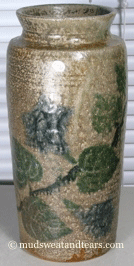
Arie Meaders
decorated vase, mid-20th c.
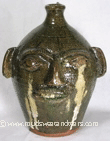
Burlon Craig weeping eyes face jug from the early 1980s.
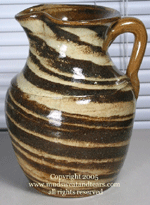
Propst swirl pitcher,
2nd quarter 20th c.
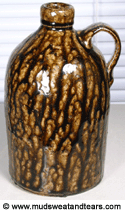
Crawford County jug, last quarter 19th c.
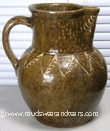
Decorated Collin Rhodes pitcher, 1840s.
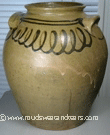
Decorated Trapp-Chandler jar, 1840s.
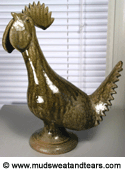
Edwin Meaders alkaline-glazed rooster, early 1980s.
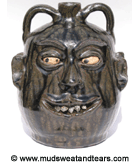
Lanier Meaders double face jug
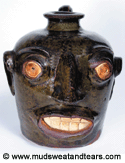
Edgefield face jug, 1870s.
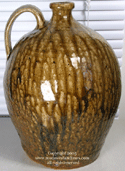
Daniel Seagle jug, 1840s.
|